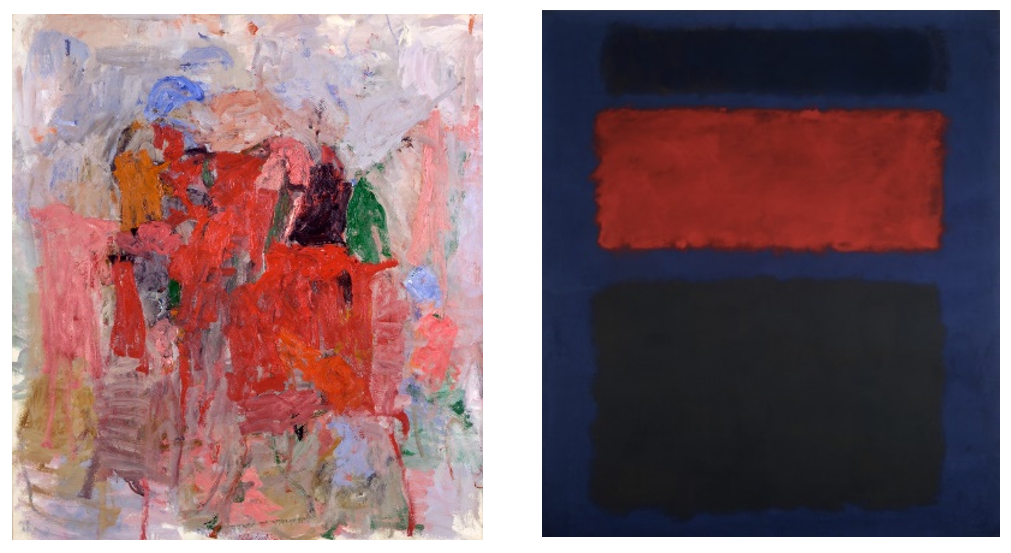London’s Royal Academy of Arts is currently showcasing some of the greatest work from the Abstract Expressionism movement. These works are fuelled by a desire to depict the human mind and experience – leading me to consider whether artistic expressions of powerful emotions could be used as a tool for improving future research and diagnoses of mental health disorders?

Could asking high risk individuals to choose images help to predict their mood patterns in the era of predictive medicine? Could Jackson Pollock’s Blue Poles (left) be used to detect chaos? Or could Rothko’s No. 15 predict a relapse of depression?
A great benefit of studying and living in London is the abundance of art exhibitions on your doorstep. A recent favourite of mine is the Abstract Expressionism show at the Royal Academy which is now drawing to a close, with pieces from many of the biggest names of the movement – Pollock, Rothko, De Kooning, Guston, and more.
Abstract Expressionism was a movement born from the common experience of artists living in 1940s New York. Emerging from an ‘era of anxiety’ that encompassed two World Wars, the Great Depression, the Spanish Civil War, atomic devastation and the subsequent Cold War, the works of art associated with it reflect the darkness of these times and the movement’s focus on contemplation and expression. Characterised by large, abstract and yet emotionally charged oil paintings, the movement was named to reflect a new style of expression which married an intensity of feeling and self-reflection with an anti-figurative aesthetic.
The show is monumental – many of the canvases are massive and the work is as you’d expect, deeply emotive. When standing in a room with several of Rothko’s paintings, described (in the information guide) as ‘darkness made visible’ it is hard to ignore the overwhelming air of melancholia. We are told that these paintings epitomise his lifelong quest to formulate abstract embodiments of powerful human emotions, or as he once memorably put it, ‘tragedy, ecstasy, doom’.

Perhaps The Mirror (left) by Philip Guston could accurately embody pain and anguish, whereas Untitled by Rothko could represent feelings of tragedy and doom.
Rothko suffered from bouts of depression and alcoholism before he committed suicide. He spent most of his later years painting these deep, dark, self-reflecting colour field works, that perhaps express more about the human condition than any figurative self-portrait. He once remarked that ‘subject is crucial, and only that subject matter is valid which is tragic and timeless’ – which rings true here, for depression can certainly be described as tragic and timeless.
“In some respects, mental health disorders are abstract expressions – they are by definition emotionally intense and yet difficult to define.”
Since visiting the show I have become intrigued by the parallels between this incredible art movement and psychiatric genetics. Abstract Expressionism is defined by its emotional intensity and anti-figurative aesthetic. In some respects, mental health disorders are abstract expressions – they are by definition emotionally intense and yet difficult to define. Unlike physical illnesses, mental health disorders have less of a ‘figurative form’ – the pathological processes are much more difficult to detect and interpret than in physical illnesses, where often we can use biological markers.
Furthermore, expression is a term used widely in genetics – genes are expressed, they orchestrate biological processes in an individual, which in turn lead to the expression of observable characteristics (or phenotypes) in that individual. Identifying genes involved in mental health disorders is a key aim of research, however research suggests that individually each gene involved only contributes a small effect. It is the combination of many small genetic effects across the genome, along with environmental effects and interactions between genes and the environment, which leads to the expression of complex behavioural traits. The best chance we have at unravelling these relationships is if we can accurately correlate individual differences in a trait with individual differences within the genome. To do this, perhaps we need a more sensitive, accessible and longitudinal method for measuring individual differences in complex behavioural traits.

Kline’s striking, aggressive brush strokes could resemble stress and agitation. De Kooning could encode fear whereas Randhart’s Abstract Painting may symbolize abject misery.
I wonder whether art could somehow be used to ‘predict’ mental illness. It can be very difficult for individuals suffering from poor mental health to articulate their feelings. Many patients are reluctant or unable to describe their thinking processes openly – and when they do, their experiences can remain difficult for others to comprehend. It is important to find new ways to encourage those affected to find an accurate narrative, so that clinicians and researchers can best tease out the significant characteristics.
“Perhaps another way of collecting population level data could be to show individuals emotionally expressive images in apps and ask them to provide feedback or rate their reaction to track their emotional state.”
Research, and hence predictive and therapeutic strategies, will advance when we can more accurately group people with similar disorders. For this we need better measurement tools for determining a patient’s type and degree of illness. At present, we rely on interviews and questionnaires, which do the job but can sometimes be inconvenient for the patient to fill out. Perhaps another way of collecting population level data could be to show individuals emotionally expressive images in apps and ask them to provide feedback or rate their reaction to track their emotional state.
This idea resembles the Rorschach ink-blot test, in which subjects’ perceptions of inkblots are recorded and then analysed. The Rorschach test was used to examine an individual’s personality characteristics and emotional functioning. Rothko, De Kooning et al. inspired me to wonder whether abstract paintings could be used in the same way. I’m neither a psychologist, nor art expert, but it is certainly worthwhile thinking about how data collection through apps using simple but engaging methods could help research.
From a clinical perspective, poor prediction and untimely intervention add to the growing burden inflicted on society by poor mental health. If we can devise ways to more accurately predict the onset of a disorder in those most vulnerable, then we are likely to save time, money and emotional distress by intervening with the appropriate psychological therapy.

